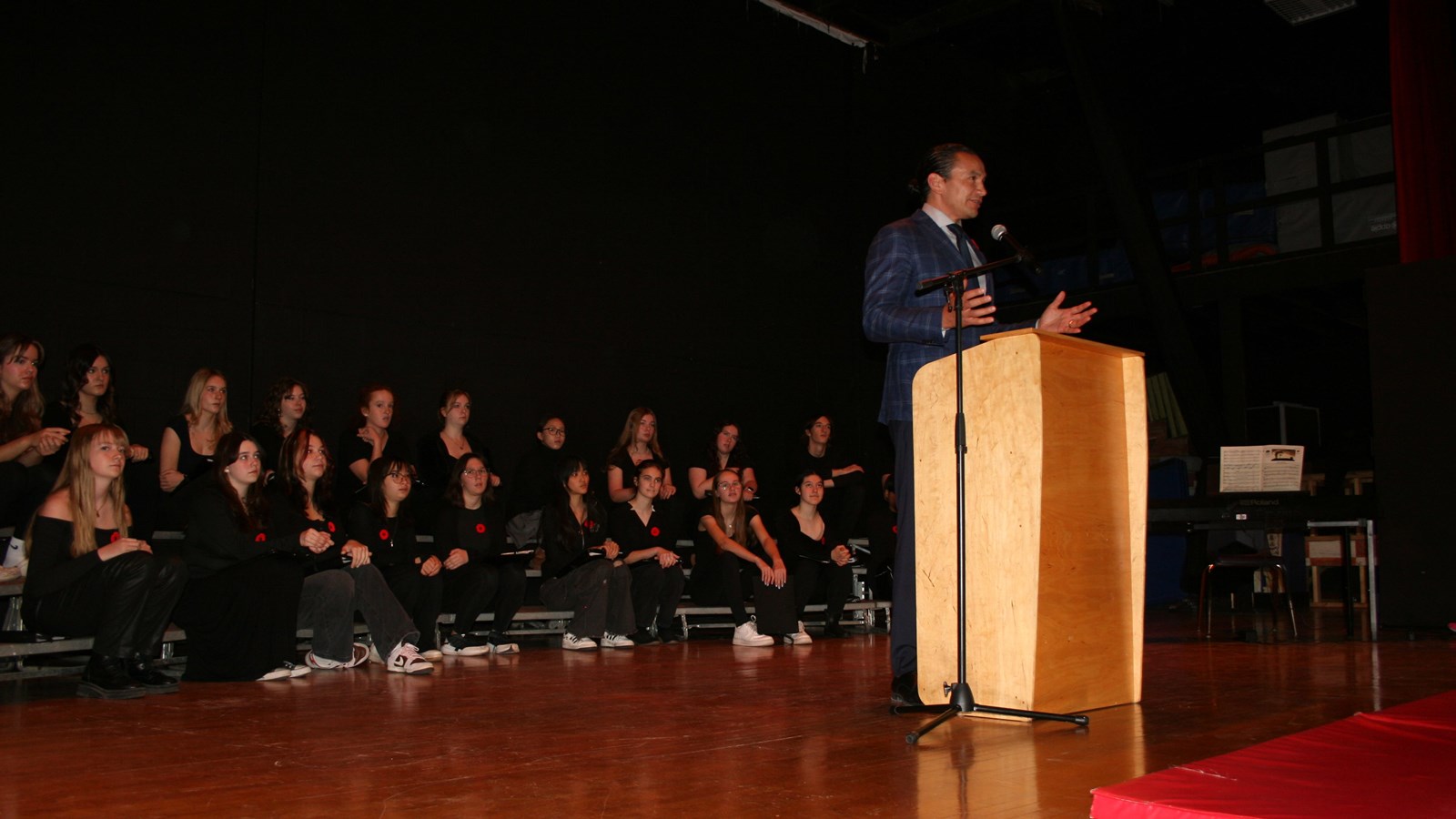Kelvin remembers
November 14, 2024 News Story
École secondaire Kelvin High School held an advance Remembrance Day service on Nov. 8, coinciding with Indigenous Veterans Day.
Premier Wab Kinew spoke at the service, detailing his trip to Normandy, France this past June for the 80th anniversary of the D-Day landings during the Second World War.
On June 6, 1944, approximately 14,000 Canadians from the 3rd Canadian Infantry Division and 2nd Canadian Armoured Brigade landed at Juno Beach as part of the Allied-invasion of German-occupied France. There were 1,096 Canadian casualties on D-Day, including 381 soldiers and airmen who were killed in action.
“It’s one of the most pivotal moments in the Second World War,” said Kinew in his speech. “It’s one of the most pivotal moments that gives us the life we enjoy here in Canada today.”
“I had a chance to meet some of the veterans, particularly a couple guys from Manitoba. Jim Parks and George Couture, they’re from Winnipeg and from Selkirk. We went out to Juno Beach, where they landed 80 years ago. They were telling me what it was like, from waking up at three in the morning, to getting on a boat, to sailing across the English channel through choppy waters, to having the boat land and then machine gun fire from the Nazis opening up on them.”
“These young men were about 19 years old at the time. When we talk about Remembrance Day, there are movies, there are books, but I want you think about yourselves. Somebody your age being asked to step into a situation like that.”
Kelvin history teacher Christopher Young is committed to making Remembrance Day relevant to his students and the broader school community.
On Nov. 6, he and the Kelvin History Club presented the Hall of Honour. The bilingual tour and display highlighted the 291 Kelvin alumni who died in action during the First and Second World Wars. Almost 3,000 Kelvin students served in the two wars.
“I think it’s key that students can connect with the personal stories of the soldiers, because if not, it’s just a number,” Young said. “It’s important that students can relate to the lives that these young people lived and learn a bit about their families, their hobbies and where they grew up.”
“When we look at their military files, the students can discover where the soldiers lived. In some cases, we’ve even gone to the homes. I think there’s a real connection when you can see that these guys came from the neighbourhood.”
Hawa Gelle, a Grade 11 student, worked on the Hall of Honour project. She said it was inspiring to learn that former Kelvin students made such a sacrifice.
“I was in complete awe,” Gelle said. “I feel like a lot of the students in the school don’t really get to see that side of Remembrance Day. With the Kelvin History Club, we wanted to tell those stories and shed light on how kids our age did admirable things for our country.”
Kristina Zaburdyaev, a Grade 11 student, also worked on the project. She was especially taken with the story of John Oliver Payne, who after surviving the Battle of Hong Kong, was taken into a Japanese prisoner-of-war camp.
“He and three other Canadians managed to escape the camp but got caught up in a typhoon. They were eventually caught and then executed,” said Zaburdyaev, who is a member of the Royal Winnipeg Rifles.
“He wrote his mom a letter, which is in National War Memorial in Ottawa. He told one of the soldiers who didn’t want to escape to give it to his mom. The letter did make it to his mom and for awhile she thought he was still alive. Like false hope.”
The Remembrance Day service also featured a tribute by Young to the late Hugh Clifford Chadderton. A Kelvin graduate, Chadderton served in the Second World War. Near Leopold Canal in Belgium, he was hit by shrapnel from a grenade and lost his right leg.
“He later recalled, ‘I should have died right there. Hell, I stepped one foot into Holland and left it there’,” Young said.
In 1965, Chadderton became the CEO of The War Amps. A Companion of the Order of Canada, he would also go onto advocate passionately for veterans’ rights.
“Cliff led a heck of a life,” said Young during his tribute. “His story makes me and hopefully you proud to be a Kelvinite. He was one of the lucky ones, surviving the most destructive war in history. But he used his good fortune to live a long and meaningful life, full of color and commitment to others. And until his last breath he remained profoundly resilient and joyful.
“In his old age, Cliff said, ‘It all hasn’t been a picnic, but I’ve always had a way of finding what the good part was.’
“Let’s do our best to find where the good part is and hold onto it with great intensity.”



.jpg)
.jpg)
.jpg)
.jpg)
.jpg)
.jpg)